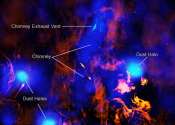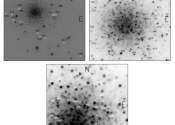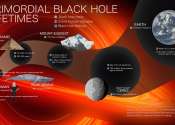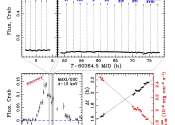Last update:
Astronomy news

A new space mission may help physicists answer 'hairy' questions about black holes
Physicists consider black holes one of the most mysterious objects that exist. Ironically, they're also considered one of the simplest. For years, physicists like me have been looking to prove that black holes are more complex ...
Astronomy
2 hours ago
0
8

Webb detects most distant black hole merger to date
An international team of astronomers have used the NASA/ESA/CSA James Webb Space Telescope to find evidence for an ongoing merger of two galaxies and their massive black holes when the universe was only 740 million years ...
Astronomy
4 hours ago
0
31

Into the abyss: Understanding black hole formation through natal kicks and neutrino emission
A new study in Physical Review Letters explores the conditions of black hole formation from dying stars, particularly the role of neutrino-induced natal kicks in the formation process.

Three new RR Lyrae variable stars discovered
Using the Lulin One-meter Telescope (LOT), astronomers have observed a newly detected candidate ultra-faint dwarf galaxy known as Virgo III. As a result, they discovered three new RR Lyrae variable stars in the vicinity of ...

Video: SOHO's view of the 11 May 2024 solar storm
Over the weekend of 10–12 May 2024, Earth was struck by the largest solar storm in more than a decade. While many of us enjoyed colorful auroras lighting up Earth's protective atmosphere, spacecraft had to endure being ...
Astronomy
23 hours ago
0
15

Hubble views the dawn of a sun-like star
Looking like a glittering cosmic geode, a trio of dazzling stars blaze from the hollowed-out cavity of a reflection nebula in this new image from NASA's Hubble Space Telescope. The triple-star system is made up of the variable ...
Astronomy
May 15, 2024
0
74

Gravitational lenses could pin down black hole mergers with unprecedented accuracy
Gravitational wave astronomy has been one of the hottest new types of astronomy ever since the LIGO consortium officially detected the first gravitational wave (GW) back in 2016. Astronomers were excited about the number ...
Astronomy
May 15, 2024
1
30

Astronomers discover merging twin quasars
Using the Subaru Telescope in Hawaii, astronomers have detected a pair of merging quasars at a high redshift, as part of the Hyper SuprimeCam (HSC) Subaru Strategic Program (SPP) survey. The serendipitous discovery is reported ...

Astronomers find the biggest known batch of planet ingredients swirling around young star
Astronomers have discovered what they believe is the biggest known batch of planet-making ingredients swirling around a young star.
Astronomy
May 14, 2024
0
694

Some clever ways to search for primordial black holes
Primordial black holes (PBHs) have recently received much attention in the physics community. One of the primary reasons is the potential link to dark matter. In effect, if PBHs can be proven to exist, there's a very good ...
Astronomy
May 14, 2024
3
42

Researchers chart Orion Nebula like never before
Star and planet formation is a messy affair. It starts with the gravitational collapse of a gigantic cloud of gas and dust, which simultaneously produces massive stars, whose intense radiation field creates a harsh environment, ...
Astronomy
May 14, 2024
0
77

Supernova SN 2023fyq exhibited long-lasting pre-explosion activity, observations show
An international team of astronomers have performed photometric and spectroscopic observations of a Type Ibn supernova, known as SN 2023fyq. Results of the observations campaign, published May 7 on the pre-print server arXiv, ...

Three stars circling the Milky Way's halo formed 12 to 13 billion years ago
MIT researchers, including several undergraduate students, have discovered three of the oldest stars in the universe, and they happen to live in our own galactic neighborhood.
Astronomy
May 14, 2024
0
82

Does the Milky Way have too many satellite galaxies?
The Large and Small Magellanic Clouds are well-known satellite galaxies of the Milky Way, but there are more. It is surrounded by at least 61 within 1.4 million light years (for context the Andromeda galaxy is 2.5 million ...
Astronomy
May 13, 2024
0
74

Scientists discover huge magnetic toroids in the Milky Way halo
The origin and evolution of cosmic magnetic fields is a long-standing unsolved question at the frontier of astronomy and astrophysics research and has been selected as one of the key areas of investigation for many major ...
Astronomy
May 13, 2024
13
106

Raspberry in the sky: Astronomers discover a new supernova remnant candidate
Astronomers from the Western Sydney University in Australia and elsewhere report the detection of a new supernova remnant (SNR) candidate. The newfound SNR candidate, dubbed "Raspberry" due to its morphology, was identified ...

Anticipating future discoveries: Scientists explore nontrivial cosmic topology
In a new Physical Review Letters (PRL) study, scientists explore the possibility of nontrivial or exotic topologies in the universe for explaining some of the anomalies seen in Cosmic Microwave Background (CMB).

The ancient Egyptian goddess of the sky: How a researcher used modern astronomy to explore her link with the Milky Way
What did our ancestors think when they looked up at the night sky? All cultures ascribed special meaning to the sun and the moon, but what about the pearly band of light and shadow we call the Milky Way?
Astronomy
May 11, 2024
0
79

Hubble Space Telescope glimpses spiral galaxy UGC 9684
The celestial object showcased in this image from the NASA/ESA Hubble Space Telescope is the spiral galaxy UGC 9684, which lies around 240 million light-years from Earth in the constellation Boötes. This image shows an impressive ...
Astronomy
May 10, 2024
0
51

NASA's Chandra notices the galactic center is venting
Using NASA's Chandra X-ray Observatory, astronomers have located an exhaust vent attached to a "chimney" of hot gas blowing away from the center of the Milky Way galaxy. Their paper describing these results is published in ...
Astronomy
May 10, 2024
1
124
Other news

Researchers develop a detector for continuously monitoring toxic gases

New sensor gives unprecedented look at changes in ATP levels inside a cell

Shedding light on perovskite hydrides using a new deposition technique

Carbon pricing works, major meta-study finds

Bioengineered enzyme creates natural vanillin from plants in one step

Researchers discover new family of bacteria with high pharmaceutical potential

Study highlights pathoblockers as a future alternative to antibiotics

A second chance for a new antibiotic agent

What can AI learn about the universe?

Quantum experts review major techniques for isolating Majoranas

Research identifies mechanism behind drug resistance in malaria parasite


























































